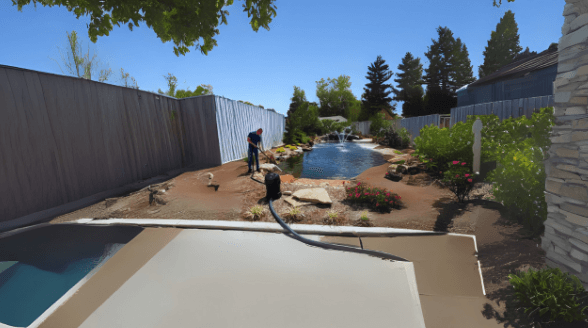Large Pond Hoover for Effortless Cleaning of Big Water Features

Maintaining a large pond is both rewarding and challenging. Algae buildup, debris, and sludge can make your pond unsightly and unhealthy. That’s where a large pond hoover comes into play. These powerful pond vacuums are engineered to handle bigger water bodies with ease, helping you keep your aquatic ecosystem clean, clear, and thriving.
In this guide, we’ll walk you through everything you need to know about using a large pond hoover, including why you should invest in one, how to use it effectively, what features to look for, and answers to common questions.
What Is a Large Pond Hoover?
A large pond hoover is a heavy-duty vacuum designed to clean debris, sludge, and algae from large ponds or water gardens. Unlike small handheld vacuums or DIY pond cleaners, these machines are equipped with powerful motors, large tanks, long hoses, and multiple nozzles to make cleaning efficient.
They work by suctioning up unwanted material from the pond bottom and edges. Some models even separate clean water and return it back to the pond, reducing water waste during cleaning.
Why You Need a Large Pond Hoover
If you own a big pond, regular cleaning with a bucket or net won’t cut it. Here’s why a large pond hoover is essential:
1. Efficient Debris Removal
Leaves, sludge, algae, and fish waste can build up over time. A hoover helps extract these without harming your pond’s balance.
2. Healthier Pond Environment
Clean water supports healthy fish, plants, and beneficial bacteria. Reducing sludge improves oxygen levels and reduces the risk of harmful bacteria and pests.
3. Time-Saving
Manual cleaning takes hours—or days. A hoover speeds up the process, especially with large surface areas and deeper ponds.
4. Protects Equipment
Clogged pumps and filters are expensive to replace. Regular vacuuming helps prevent system failures by reducing debris overload.
How to Use a Large Pond Hoover Effectively
Using a pond vacuum might sound complex, but the process is straightforward if you follow a few best practices.
Step 1: Read the User Manual
Each model has specific instructions. Always read the manual for setup, safety, and usage directions.
Step 2: Prepare Your Pond
Remove large twigs or foreign objects. Check that fish and plants are safe from direct suction.
Step 3: Position the Hoover
Place it on a stable, level surface near the pond. Ensure the power cord and hose reach all required areas.
Step 4: Start from the Shallow End
Begin cleaning at the shallowest point and move towards the deeper areas. This prevents murky water from spreading to cleaner zones.
Step 5: Use the Right Nozzles
Most hoovers come with different heads—for sludge, gravel, flat surfaces, and corners. Switching nozzles ensures thorough cleaning.
Step 6: Empty Waste Tank Regularly
Don’t let the tank overfill. Empty it periodically to maintain suction power.
Step 7: Post-Cleaning Care
Rinse the hoover parts and allow them to dry. Store in a dry place to extend equipment life.
Which Features to Look for in a Large Pond Hoover
Not all vacuums are created equal. Here are the must-have features when choosing a hoover for large ponds:
1. Powerful Motor (≥1600W)
More wattage means stronger suction and faster debris removal.
2. Large Tank Capacity
Look for a hoover with a minimum of 30–40 liters. Larger tanks mean fewer interruptions.
3. Long Hose and Cord Length
At least 4–6 meters of hose is ideal for wide coverage. A longer power cable also improves flexibility.
4. Multiple Nozzle Attachments
Sludge, gravel, and algae need different treatments. Nozzles designed for specific cleaning help improve efficiency.
5. Continuous Operation Mode
Some models auto-drain the tank so you can clean continuously without stopping to empty.
6. Durability and Build Quality
Look for corrosion-resistant materials, waterproof casing, and strong wheels or handles for easy mobility.
Who Should Use a Large Pond Hoover?
A large pond hoover isn’t just for professionals. It’s ideal for:
- Pond owners with water features larger than 1000 gallons
- Fishkeepers who want optimal water conditions
- Gardeners with decorative koi or ornamental ponds
- Caretakers of public parks or estates with natural ponds
Whether you’re a homeowner, landscaper, or pond enthusiast, investing in the right vacuum can save money and stress in the long run.
Final Thoughts on Choosing a Large Pond Hoover
Keeping your pond clean is more than just aesthetics—it’s about creating a healthy ecosystem for all life inside it. A large pond hoover simplifies the work, ensuring you spend more time enjoying your pond and less time maintaining it.
Before buying, make sure to compare models based on motor power, tank size, hose length, and extra features like continuous discharge and nozzle variety. Choose a model that matches your pond’s size and your maintenance routine.
Clearing Up Confusion
Q1: Can I use a regular wet/dry vacuum for pond cleaning?
No. Regular shop vacs aren’t designed for underwater use and may be unsafe or ineffective in removing sludge and algae.
Q2: How often should I clean my pond with a hoover?
For large ponds, a deep clean every 4–6 weeks during peak seasons (spring/summer) is ideal. Light maintenance can be done more frequently.
Q3: Do pond hoovers remove beneficial bacteria?
Surface-level vacuuming won’t significantly disturb the bacteria in your pond filter. But excessive cleaning might affect balance, so avoid over-vacuuming.
Q4: Is it safe to use a pond hoover with fish in the water?
Yes—just be careful not to suck up small fish or damage delicate plants. Use protective screens and low-suction settings in fish zones.
Q5: What’s the average price of a large pond hoover?
Prices range from $200 to $1000 depending on brand, motor size, and features. It’s a worthwhile investment if you want minimal manual maintenance.



